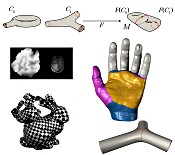PhD thesis

I defended my PhD thesis on Octobre 22nd, 2009 at 2pm, in amphi 3 of the Pôle Commun (ISIMA), Clermont-Ferrand, France. Its name is “Tools for tiling surfaces” (« Outils pour le pavage de surfaces »).
Download
- A final version of my PhD thesis is available here: PhD manuscrit (pdf, french)
- The slides of my defense are also available: slides of the defense (pdf)
Membres du jury
- Jean-Marc Chassery (rapporteur) ;
- Bruno Lévy (rapporteur) ;
- Pierre Alliez (examinateur) ;
- Éric Colin de Verdière (examinateur) ;
- Yan Gérard (visiteur) ;
- Philippe Mahey (président) ;
- Vincent Barra (directeur de thèse).
Abstract
The amount of data available to describe the geometry of a 3D object is ever increasing, and therefore ways to efficiently process it are essential. In this dissertation, we present a collection of tools for surface manipulation that exploit both their geometric and topological properties.
First we describe some classical results of topology, the framework and main algorithms for surface cutting. We then introduce the M-tiles and M-tiling concepts, which notably offer great combinatorial flexibility while allowing to describe the results from topological cutting algorithms with precision. Thanks to the descriptive power of this formalism we introduce various cutting algorithms, which take into account not only the topology and geometry of the surfaces but also the properties of the M-tiles resulting from the cuttings. We also introduce in this dissertation a generalization of loops we call n-loops, which allow the description of a new approach for tiling surfaces with cylindrical patches first and then quadrangles.
Two applications of these cutting tools are finally presented. First, in the context of computer graphics, we describe a set of tools based on the new cutting algorithms to aid surface manipulation. Then, we describe a complete framework for medical imaging, that produces a dynamic visualization interface to display complex data on planar brain maps. The suitability of this visualization is illustrated in the context of cortical stimulation.
Finally, we discuss the future perspectives offered by our novel developments, e.g. by exploiting the potential of n-loops and M-tilings, which we believe to be numerous. We also underline the richness provided by exploiting computational geometry tools in the context of the aforementioned application fields.
See also
- The illustrations page of this website is dedicated to the illustrations available in annex D of the thesis.